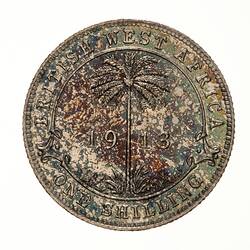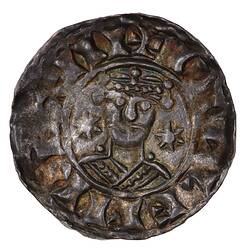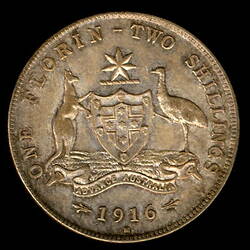Summary
1 Shilling, Issued by, British West Africa, 1913
Minted by Royal Mint, London
Obverse Description
Crowned and draped bust of the King facing left, the King is wearing the Imperial Crown and the ermine Robe of State, the Collar of the Most Noble Order of the Garter, and the Badge of the Most Honourable Order of the Bath; around, GEORGIVS V D.G. BRITT: OMN: REX F.D. IND: IMP:; artist's initials BM on bust truncation
Reverse Description
At centre, dividing the date, 1913, a palm tree; around outside a circle broken be decorative extensions adjacent to the date, BRITISH WEST AFRICA ONE SHILLING
Edge Description
Milled
Significance
In 1912 a West African Currency Board was established to arrange for the production and supply of coins. The first issue of silver, in the denominations 3 pence, 6 pence, shilling and 2 shillings, was struck at the Royal Mint, London in 1913, and made legal tender in Nigeria, Gold Coast, Sierra Leone and Gambia by a local Currency Act dated 26 June 1913. 1913 was also a year when a large crop of cocoa valued at almost 2 1/2 million pounds saw a great demand for silver coins. In addition to 889,000 pound of West African silver (all the Royal Mint could strike) and additional 539,700 pound of Imperial silver coin was needed. Such fluctuation in demand made the provision of a silver coinage very difficult. During World War I 530,000 pound of silver coin was returtned to Britain for sale as bullion to raise internationally accepted forms of money. Interest in the production of a silver coinage led to the request for the provision of proof and specimen sets for official commemorative gifts. Sets containing two coins of each denomination were struck in proof quality while single coin sets were selected uncirculated specimens. The two sets in the Museum Victoria collection are selected uncirculated quality - as usual at that time, no cases were retained.
More Information
-
Collecting Areas
-
Acquisition Information
Transfer from Melbourne Branch of Royal Mint, 11 Jan 1978
-
Date Issued
1913 AD
-
Issued By
-
Mint
-
Artist
-
Denomination
-
Material
Silver
-
Axis
12
-
Classification
-
Category
-
Discipline
-
Type of item
-
Dimensions
23 mm (Outside Diameter), 5.655 g (Weight)
-
Shape
Round
-
References
KM#12 Vice 39
[Book] Vice, David. 1983. The Coinage of British West Africa & St. Helena 1684 - 1958.
[Book] Bruce, Colin R. 2009. 2009 Standard Catalogue of World Coins 1901 - 2000.
-
Keywords







